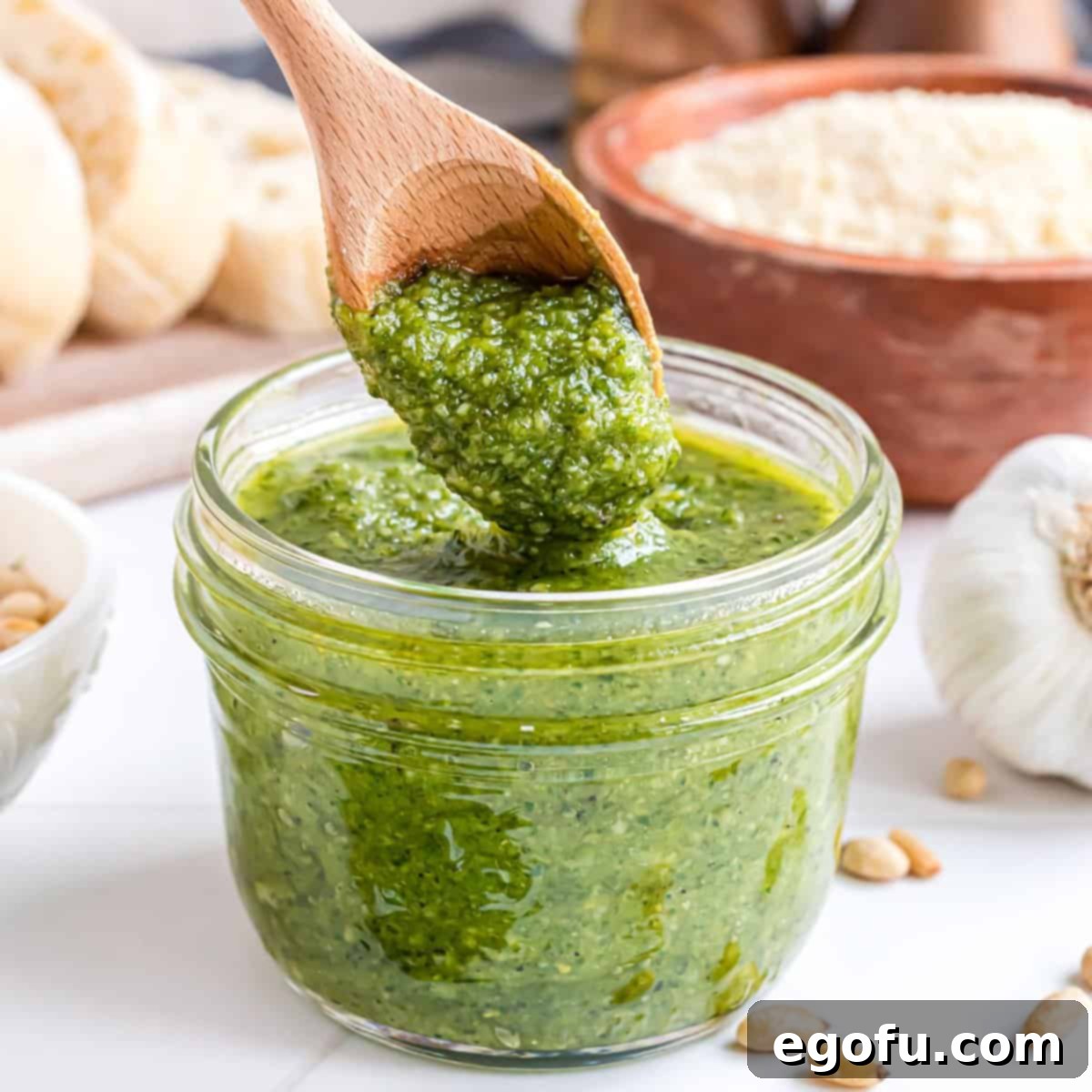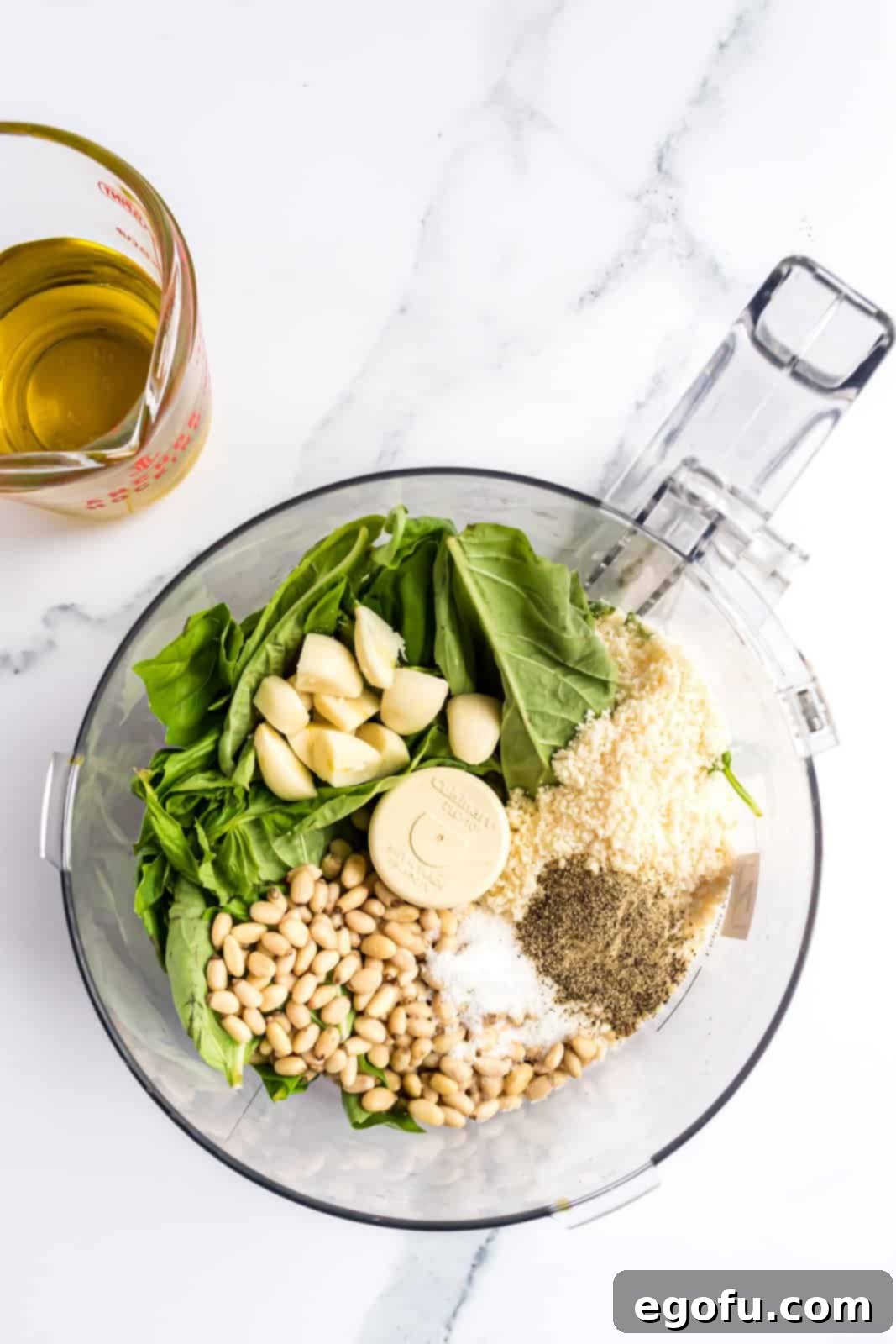Welcome to the ultimate guide for crafting the most exquisite homemade pesto sauce right in your own kitchen! Forget the store-bought versions; once you experience the vibrant freshness and unparalleled flavor of this super easy recipe, you’ll never look back. Prepare to transform your culinary creations with this simple yet sensational condiment that comes together in mere minutes.
Harvesting Flavor: The Magic of Homemade Pesto with Fresh Basil
There’s an undeniable charm and robust flavor that only fresh, homemade basil pesto can deliver. While commercial pesto serves its purpose in a pinch, the homemade variety elevates any dish with its bright, aromatic profile. This recipe promises a perfectly balanced medley of pungent garlic, nutty Parmesan cheese, earthy pine nuts, rich extra virgin olive oil, and, of course, an abundance of fragrant fresh basil leaves. It’s a symphony of tastes that will truly knock your socks off! In just a few straightforward steps, you’ll create a versatile sauce that will quickly become a cherished staple in your kitchen, impressing family and friends alike with its authentic taste and incredible freshness.
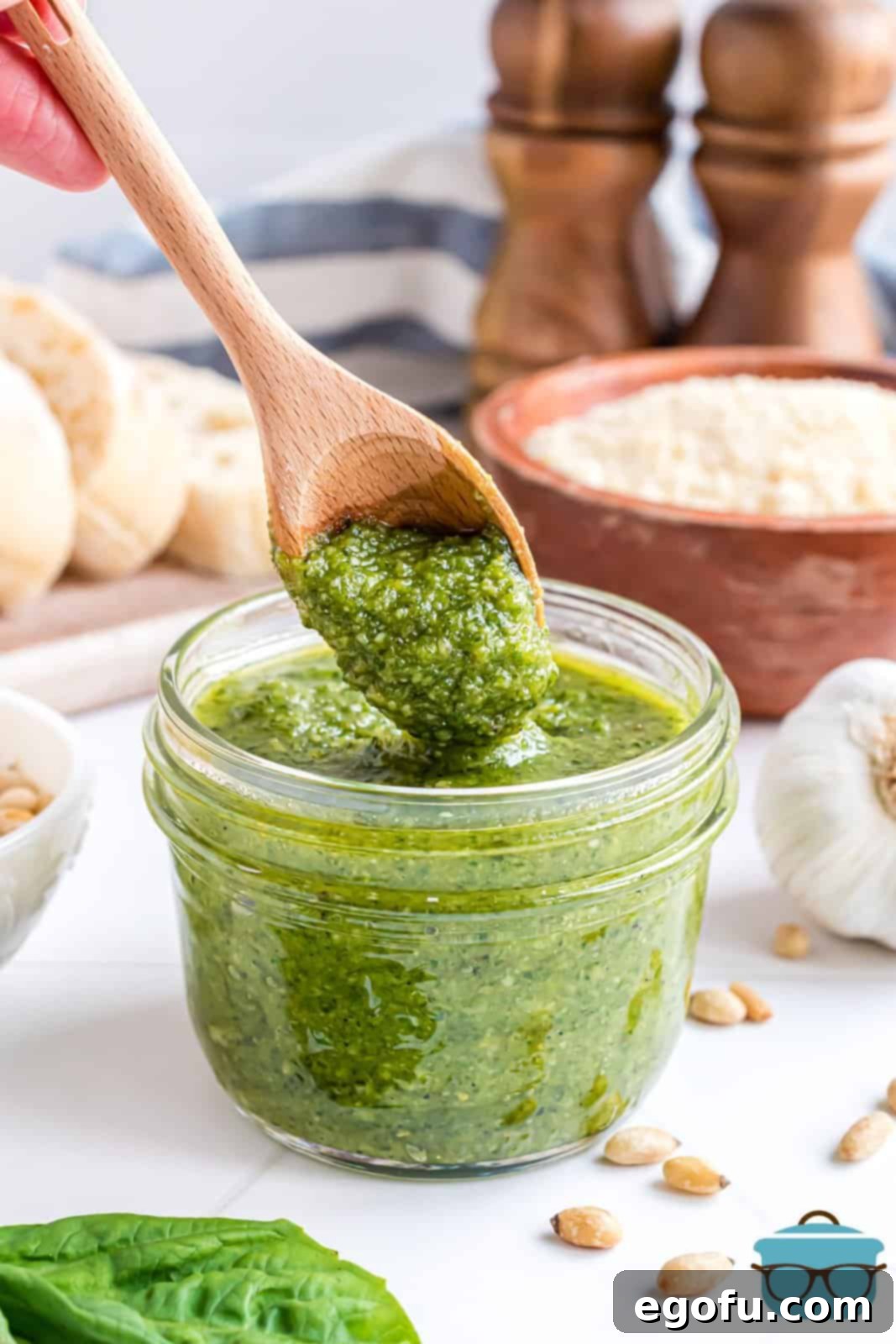
Your Pesto Questions Answered: FAQs About This Versatile Sauce
Basil pesto is an incredibly versatile sauce, offering an endless array of culinary possibilities. Its rich, herbaceous flavor makes it a fantastic addition to countless dishes, whether you use it as a simple spread, a flavorful dip, or a vibrant ingredient within a larger recipe. Here are some of our favorite creative ways to incorporate homemade pesto into your meals:
- As a Dip for Bread: Serve it alongside warm crusty bread, focaccia, or pita for an easy appetizer.
- Crostini Topping: Spread pesto on toasted crostini or other crunchy bread, then top with fresh diced tomatoes, a sprinkle of mozzarella, or a balsamic glaze.
- Elevate Your Pasta: Stir it into your favorite cooked pasta for a quick and flavorful meal. It pairs beautifully with both long and short pasta shapes.
- Flavorful Soup Enhancer: Swirl a spoonful of pesto into hot soups, like minestrone or vegetable soup, just before serving to add depth and a fresh herbaceous note.
- Pizza Perfection: Use it as a unique and delicious base for your pizza instead of traditional tomato sauce, or dollop it on top of your pizza after baking for an extra burst of flavor.
- Veggie Boost: Toss roasted or grilled vegetables with pesto for an instant flavor upgrade, or stuff it into chicken breasts before baking for a savory filling.
- Salmon Sensation: Spoon it over baked or grilled salmon fillets for a bright, zesty finish.
- Meat Marinade: Utilize pesto as a marinade for chicken, pork, or even lamb to infuse your meats with incredible flavor before grilling or roasting.
- Sandwich & Wrap Spread: Spread it on sandwiches, wraps, or paninis as a vibrant alternative to mayonnaise or mustard.
- Creamy Dip Base: Mix pesto with sour cream, Greek yogurt, or cream cheese to create a delightful dip for raw vegetables, chips, or crackers.
- Recipe Integration: Don’t limit yourself! Try incorporating it into recipes like Caesar Basil Pasta Salad, Italian Sub Squares, Tuscan Chicken Pasta, and Italian Gnocchi Soup for an extra layer of deliciousness.
Yes, absolutely! It’s crucial to rinse your fresh basil leaves thoroughly under cool running water before using them in your pesto. Even if they look clean, basil can harbor dirt, dust, or small insects. After rinsing, gently pat the leaves completely dry with a paper towel or use a salad spinner. Avoid submerging the basil in water for extended periods, as this can bruise the delicate leaves and diminish their vibrant flavor.
For traditional pesto, high-quality extra virgin olive oil is the gold standard, and it’s what I personally prefer. Its fruity, slightly peppery notes complement the other ingredients beautifully. However, if you find extra virgin olive oil too robust or prefer a milder flavor, you can opt for a lighter-tasting olive oil or even a blend. The key is to choose an oil that doesn’t have an overpowering flavor that would compete with the fresh basil and garlic. A good quality, mild olive oil will ensure the other ingredients shine.
While toasting pine nuts is an optional step, I wholeheartedly recommend it! This simple process deepens their flavor, adding a wonderfully aromatic and nutty dimension to your pesto that truly makes a difference. To toast your pine nuts:
- Place a medium-sized, dry skillet (no oil or butter needed) over medium-low heat.
- Add the pine nuts to the pan in a single layer.
- Cook for 6-7 minutes, stirring them frequently.
- Keep a very close eye on them! Pine nuts can go from perfectly golden to burnt in a matter of seconds due to their high oil content. Remove them from the heat as soon as they turn a light golden-brown and become fragrant.
- Immediately transfer them to a plate to cool, preventing them from continuing to cook in the hot pan.
No, you don’t strictly have to use pine nuts if you can’t find them, have an allergy, or simply prefer to omit them. Traditional pesto calls for pine nuts, but there are excellent alternatives. If you’re skipping nuts entirely, begin with only ⅓ cup of olive oil and gradually add more until your pesto reaches the desired consistency. If you’re looking for substitutes, walnuts, cashews, or even almonds make fantastic alternatives. Each will impart a slightly different nuance to the flavor profile, allowing for delicious variations.
It is absolutely normal for homemade pesto to change color and darken over time, especially when stored in the refrigerator. This natural discoloration, often turning a darker green or even brownish on the surface, is primarily due to oxidation as the basil leaves come into contact with air. Rest assured, this change in color does not affect the delicious flavor or safety of your pesto. However, if you prefer to maintain that vibrant green hue, here are a few tips:
- Olive Oil Barrier: After placing pesto in an airtight container, pour a thin layer of extra virgin olive oil on top. This creates a barrier that prevents air from reaching the pesto, significantly reducing oxidation.
- Lemon Juice: Add about a tablespoon of fresh lemon juice to your pesto when blending. Lemon juice acts as a natural antioxidant, helping to preserve the color and adding a lovely bright note to the flavor.
- Blanching Basil: For the most vibrant green pesto, you can blanch your basil leaves. Quickly plunge them into boiling water for about 30 seconds, then immediately transfer them to an ice bath. Once chilled, wring out all excess water from the leaves before adding them to your food processor. This process sets the chlorophyll in the basil, helping it retain its bright color.
Proper storage is key to enjoying your homemade pesto for as long as possible. For short-term storage, transfer your pesto to an airtight container and keep it in the refrigerator for up to a week. As mentioned, it’s perfectly normal for the color to deepen; this won’t impact the taste. For longer preservation, freezing is an excellent option that allows you to savor your fresh pesto for months.
Freezing pesto is a fantastic way to extend its shelf life and ensure you always have a batch ready for future meals. There are two primary methods for freezing pesto, each offering convenience depending on how you plan to use it:
- Freezing in Containers: Spoon the pesto into an airtight, freezer-safe container. Ensure there’s a thin layer of olive oil on top before sealing to prevent freezer burn and color changes. Pesto can be safely stored this way for 6 months or even longer. Thaw in the refrigerator before use.
- Freezing in Ice Cube Trays: For convenient, single-serving portions, transfer your pesto into standard ice cube trays. Freeze until solid. Once the pesto cubes are completely frozen, pop them out of the trays and transfer them to a freezer-safe bag or container. Each cube typically holds about 2 tablespoons of pesto, making it incredibly easy to grab just what you need for a recipe. These frozen cubes can be stored in the freezer for easy access and extended freshness.
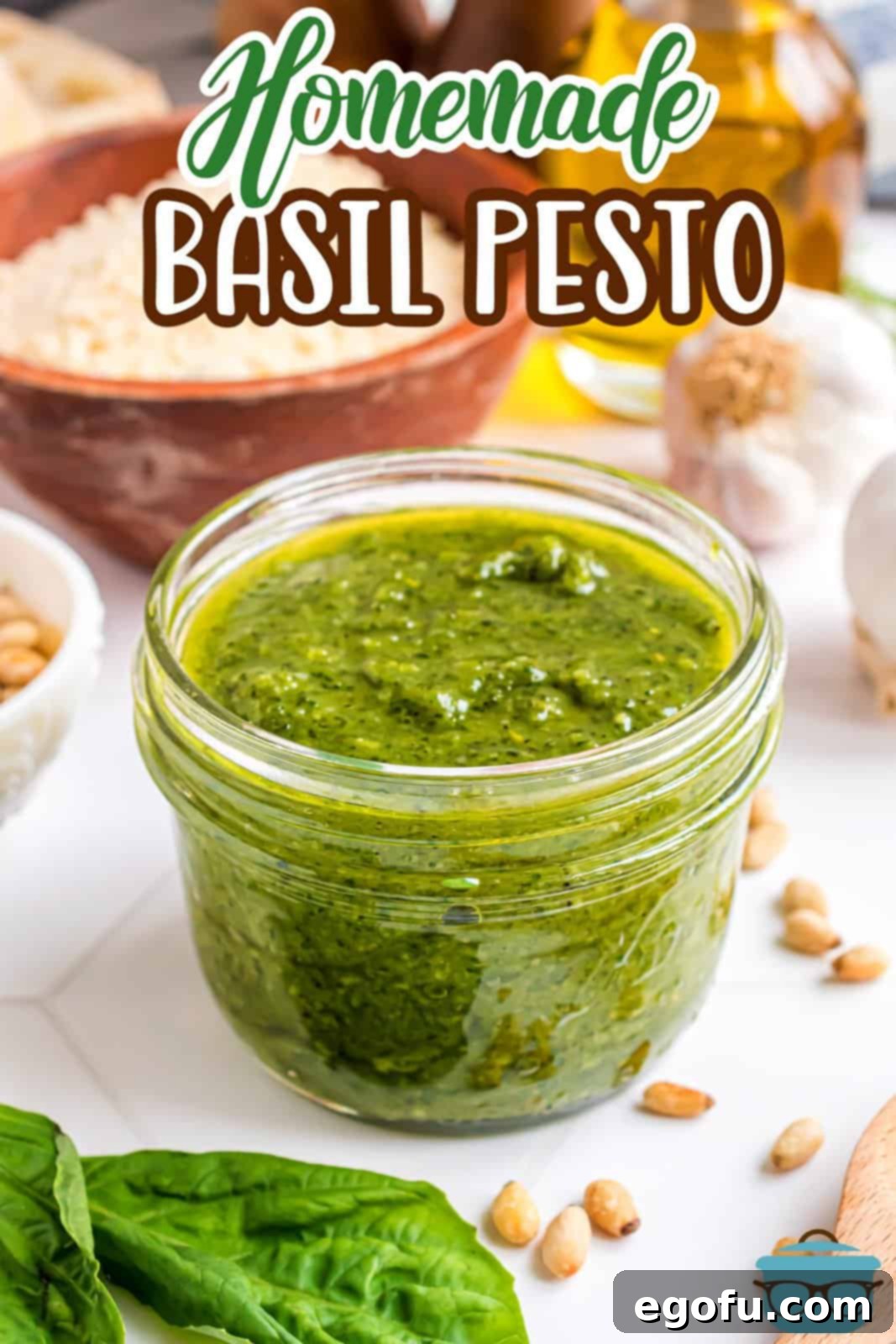
Essential Ingredients for Perfect Homemade Pesto: (See Recipe Card Below for Full Recipe Details)
Crafting exceptional pesto begins with selecting the finest ingredients. Each component plays a crucial role in building the layered flavors that make this sauce so irresistible:
- Fresh Basil Leaves: This is the star of the show, so quality is paramount. It’s absolutely essential to use fresh basil here—avoid frozen or dried varieties, as they won’t provide the same vibrant flavor or texture. Look for bright green leaves that are plump and free from any dark spots or wilting. Gently packed, you’ll need about two cups to achieve that iconic basil aroma and taste.
- Fresh Garlic: Fresh garlic is non-negotiable for authentic pesto. While I often use jarred garlic in other recipes for convenience, for pesto, the pungent, fresh bite of whole garlic cloves makes a significant difference. Trust me, it’s worth peeling a few cloves for this recipe!
- Pine Nuts: These small, buttery nuts are a traditional component of pesto, contributing a subtle richness and creamy texture. While optional, toasting them beforehand enhances their nutty flavor beautifully (see FAQ above for how to toast). You can typically find pine nuts in the baking aisle alongside other nuts at your local grocery store.
- Parmesan Cheese: Opt for freshly grated Parmesan cheese. Pre-grated cheeses often contain anti-caking agents that can affect the texture and flavor. Freshly grated Parmesan offers a bright, salty, and sharp flavor that elevates the pesto’s overall profile. These “little things” truly make a big difference in the final taste.
- Extra Virgin Olive Oil: As the binder for all these wonderful ingredients, olive oil adds its own distinct flavor and helps achieve the desired consistency. I prefer extra virgin olive oil for its rich, complex taste, but feel free to choose an olive oil whose flavor you genuinely enjoy. A lighter-tasting olive oil will work perfectly if you prefer a less intense olive flavor.
- Kosher Salt and Freshly Ground Black Pepper: These seasonings enhance and tie all the flavors together. Start with the recommended amounts and adjust to your personal preference.
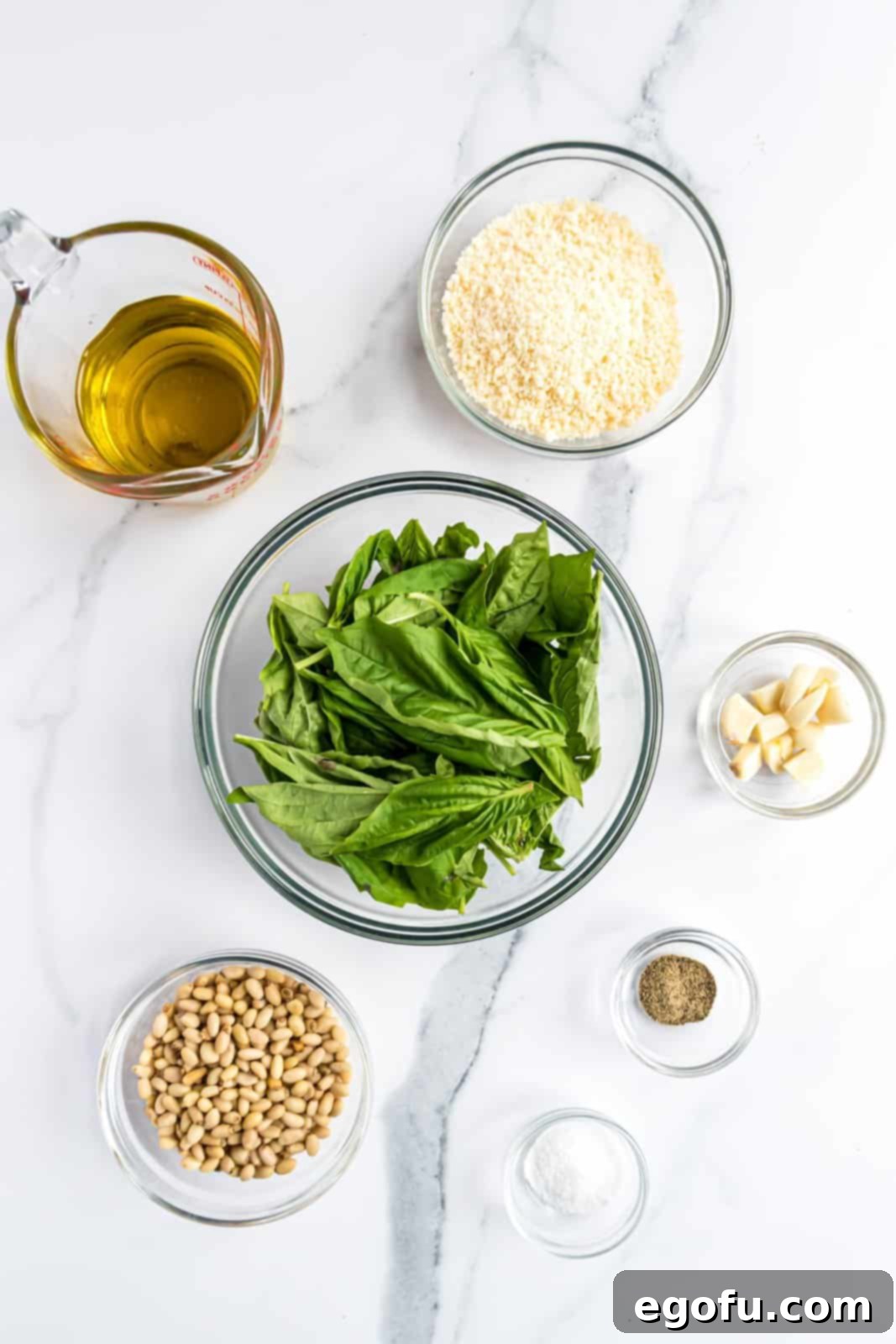
Crafting Your Own Pesto: A Simple Step-by-Step Guide
Making homemade pesto is surprisingly simple and incredibly rewarding. With just a few minutes and a food processor or blender, you can create a vibrant, flavorful sauce that far surpasses any store-bought variety. Here’s how to do it:
- Combine the Ingredients: Start by adding all your prepared ingredients into the bowl of a blender or a mini food processor. This includes your two cups of fresh basil leaves (ensure they are washed and thoroughly dried), 2-3 cloves of fresh garlic (peeled), ½ cup of toasted pine nuts (if using), ½ cup of freshly grated Parmesan cheese, 1 teaspoon of kosher salt, ½ teaspoon of freshly ground black pepper, and ½ cup of your chosen olive oil.

- Blend Until Smooth: Secure the lid and begin to blend the mixture. Pulse repeatedly, scraping down the sides of the processor bowl as needed to ensure all ingredients are evenly incorporated. Continue blending until the mixture is well combined and reaches a smooth, paste-like consistency. You want it to be thick but still pourable.

- Adjust Consistency: If your pesto appears too thick or chunky for your preference, gradually add a little more olive oil, a tablespoon at a time, while continuing to blend. This will help thin it out to your desired consistency. Taste and adjust seasonings (more salt or pepper) if necessary.
- Serve and Enjoy: Once your pesto reaches the perfect texture and flavor, it’s ready to be enjoyed immediately! Transfer it to a serving dish, a jar for storage, or directly incorporate it into your favorite recipes.
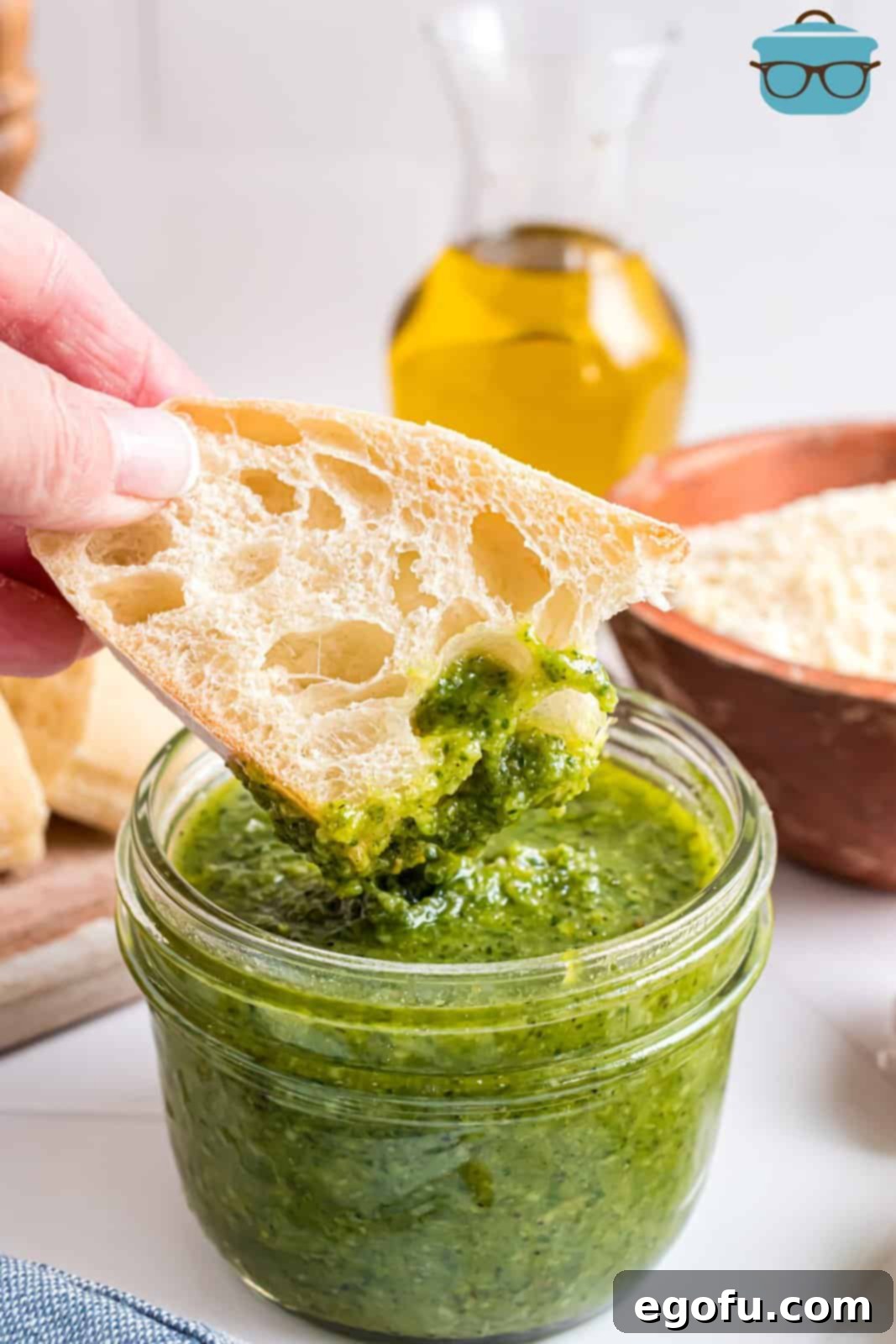
Craving More Delicious Recipes?
- Grilled Chicken Pesto Pasta
- Pesto Pasta Salad
- Homemade Marinara Sauce
- Homemade BBQ Sauce
- Homemade Pizza Sauce
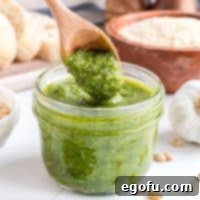
Homemade Pesto Sauce
Print
Pin
Rate
10 minutes
10 minutes
4
servings
Brandie Skibinski
Ingredients
-
2
cups
fresh basil leaves
packed -
2-3
cloves
garlic
-
½
cup
pine nuts
toasted -
½
cup
freshly grated Parmesan cheese
-
1
teaspoon
kosher salt -
½
teaspoon
black pepper
-
½
cup
olive oil
Instructions
- To make the pesto, add 2 cups fresh basil leaves, 2-3 cloves garlic, ½ cup pine nuts, ½ cup freshly grated Parmesan cheese, 1 teaspoon kosher salt, ½ teaspoon black pepper and ½ cup olive oil into a blender or mini food processor.
- Blend the mixture until it is well combined and has a paste-like consistency. If the pesto is too thick, you can add some extra olive oil to thin it out to your desired consistency.
Notes
- Please refer to the FAQ’s and ingredient list above for other substitutions or for answers to common questions.
- Store pesto in an airtight container and keep it in the fridge for up to a week.
- For longer preservation, freeze it for 6 months or more in a freezer-safe container or as individual ice cubes.
Seasonings, Side Dish
American
Nutrition
Calories:
410
kcal
|
Carbohydrates:
5
g
|
Protein:
7
g
|
Fat:
42
g
|
Sodium:
802
mg
|
Fiber:
1
g
|
Sugar:
1
g
Nutritional Disclaimer
“The Country Cook” is not a dietician or nutritionist, and any nutritional information shared is an estimate. If calorie count and other nutritional values are important to you, we recommend running the ingredients through whichever online nutritional calculator you prefer. Calories and other nutritional values can vary quite a bit depending on which brands were used.
Did you make this recipe?
Share it on Instagram @thecountrycook and mention us #thecountrycook!
